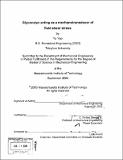| dc.contributor.advisor | C. Forbes Dewey, Jr. | en_US |
| dc.contributor.author | Yao, Yu, Ph. D. Massachusetts Institute of Technology | en_US |
| dc.contributor.other | Massachusetts Institute of Technology. Dept. of Mechanical Engineering. | en_US |
| dc.date.accessioned | 2007-01-10T16:56:47Z | |
| dc.date.available | 2007-01-10T16:56:47Z | |
| dc.date.copyright | 2005 | en_US |
| dc.date.issued | 2005 | en_US |
| dc.identifier.uri | http://hdl.handle.net/1721.1/35653 | |
| dc.description | Thesis (S.M.)--Massachusetts Institute of Technology, Dept. of Mechanical Engineering, 2005. | en_US |
| dc.description | Includes bibliographical references (p. 51-56). | en_US |
| dc.description.abstract | It is widely recognized that fluid shearing forces acting on endothelial cells (ECs) have a profound effect on EC morphology, structure and function. Recent investigations in vivo have indicated the presence of a thick endothelial surface layer, also called the glycocalyx, with an estimated thickness on the scale of 0.5 pm, which restricts the flow of plasma and can exclude red blood cells and some macromolecular solutes. Based on our current understanding of signal transduction, we expect that the glycocalyx plays an essential role as a possible mechanotransducer of fluid shear stress to the actin cytoskeleton of the endothelial cells. We examined whether removing the glycocalyx can affect shear-induced cellular response, e.g. cell migration speed and wound edge healing. More specifically, we compared the two major components of the glycosaminoglycans in the glycocalyx, which are heparan sulfate GAGs and chondroitin sulafte GAGs. Our results showed that the removal of heparan sulfate GAGs has a much greater impact on the shear induced response compared to chondroitin sulfate GAGs, and the short term crawling speed response is highly suppressed in the first case. Therefore, it is highly possible that heparan sulfate GAGs is involved in the shear-induced signaling pathway. | en_US |
| dc.description.statementofresponsibility | by Yu Yao. | en_US |
| dc.format.extent | 56 p. | en_US |
| dc.format.extent | 2387305 bytes | |
| dc.format.extent | 2389595 bytes | |
| dc.format.mimetype | application/pdf | |
| dc.format.mimetype | application/pdf | |
| dc.language.iso | eng | en_US |
| dc.publisher | Massachusetts Institute of Technology | en_US |
| dc.rights | M.I.T. theses are protected by copyright. They may be viewed from this source for any purpose, but reproduction or distribution in any format is prohibited without written permission. See provided URL for inquiries about permission. | en_US |
| dc.rights.uri | http://dspace.mit.edu/handle/1721.1/7582 | |
| dc.subject | Mechanical Engineering. | en_US |
| dc.title | Glycocalyx acting as a mechanotransducer of fluid shear stress | en_US |
| dc.type | Thesis | en_US |
| dc.description.degree | S.M. | en_US |
| dc.contributor.department | Massachusetts Institute of Technology. Department of Mechanical Engineering | |
| dc.identifier.oclc | 76761955 | en_US |
